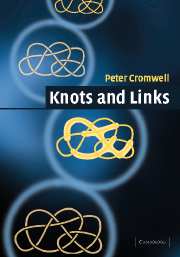Book contents
- Frontmatter
- Contents
- Preface
- Notation
- 1 Introduction
- 2 A Topologist's Toolkit
- 3 Link Diagrams
- 4 Constructions and Decompositions of Links
- 5 Spanning Surfaces and Genus
- 6 Matrix Invariants
- 7 The Alexander–Conway Polynomial
- 8 Rational Tangles
- 9 More Polynomials
- 10 Closed Braids and Arc Presentations
- Appendix A Knot Diagrams
- Appendix B Numerical Invariants
- Appendix C Properties
- Appendix D Polynomials
- Appendix E Polygon Coordinates
- Appendix F Family Properties
- Bibliography
- Index
- Frontmatter
- Contents
- Preface
- Notation
- 1 Introduction
- 2 A Topologist's Toolkit
- 3 Link Diagrams
- 4 Constructions and Decompositions of Links
- 5 Spanning Surfaces and Genus
- 6 Matrix Invariants
- 7 The Alexander–Conway Polynomial
- 8 Rational Tangles
- 9 More Polynomials
- 10 Closed Braids and Arc Presentations
- Appendix A Knot Diagrams
- Appendix B Numerical Invariants
- Appendix C Properties
- Appendix D Polynomials
- Appendix E Polygon Coordinates
- Appendix F Family Properties
- Bibliography
- Index
Summary
At the end of Chapter 4, we saw how links could be decomposed into fragments called tangles. In particular, rational links have a decomposition into two trivial 2-tangles. In the last chapter we introduced a more rigid framework for studying 2-tangles using marked tangles. We now investigate the marked tangles that can be used to build rational links. This leads to a particularly nice classification scheme and a close relationship with the rational numbers, whence the name.
Generating rational tangles
A rational tangle is homeomorphic to the trivial 2-tangle. This means that it can be ‘unwound’ by sliding the endpoints around on the boundary sphere. We want to use this idea in reverse, starting with a basic object and applying a sequence of operations to it to build up complex-looking tangles.
Let us first define four operations that can be performed on a marked tangle (see Figure 8.1):
H Take the two right-hand ends (NE and SE) and twist them so that the over-crossing strand created has positive gradient.
V Take the two lower ends (SW and SE) and twist them so that the over-crossing strand created has positive gradient.
R The points NW and SE determine a line through the tangle. Using this line as an axis, rotate the tangle 180°.
F The points NW and SE determine a plane through the tangle that is orthogonal to the equatorial plane. Reflect the tangle in this plane. (Recall that the equatorial plane is the one containing the four end-points.)
- Type
- Chapter
- Information
- Knots and Links , pp. 189 - 214Publisher: Cambridge University PressPrint publication year: 2004



